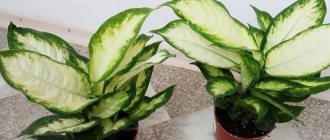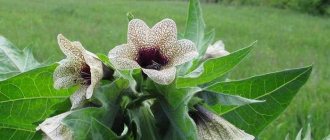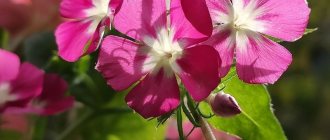Is there an allergy to geranium, given its benefits?
In folk practice, geranium
is quite common for treating infections of the mouth and nose.
It has many beneficial properties
, which are expressed in antibacterial and antiseptic terms. Folk recipes with geranium allow you to create decoctions that are used for various laryngeal and oral infections.
Among other things, geranium has the following properties:
- it is used as an anti-cellulite agent. It speeds up the work of blood and its circulation in the body system;
- has a beneficial effect on the cardiac system;
- prevents the development of tachycardia and coronary disease;
- purifies the air;
- improves the home atmosphere.
For a long time it was worth having a pot of geraniums in the house, then peace and comfort reigned in the house, and the children grew up as obedient and kind people.
Causes of allergic reactions
While cultivating green spaces, a person may notice the following symptoms: constant runny nose, sneezing, puffy eyes, incessant cough. Often the patient mistakes the symptoms of an allergy to indoor flowers for an infectious or cold disease, without stopping contact with the allergen.
There are a number of reasons that contribute to the development of allergies to green spaces:
- A predisposition of the body, manifested by allergies to food, household chemicals, indoor dust or certain types of mold, hair or fluff of pets, etc.
- External factors that reduce the body’s protective properties: poor environmental conditions, living in areas with high gas pollution, cigarette smoke.
- Types of flowers that pose a danger to allergy sufferers, which are unknowingly grown at home.
Allergy to wild and domestic flowers often manifests itself in the form of hay fever (allergic manifestations to pollination of flowers). The main source of trouble in such cases are wild shrubs and trees, which bloom in late spring and early summer.
During this period, an allergy to indoor flowers may begin, and the symptoms of the disease will be similar to those of hay fever.
Often, negative manifestations on the flowering of indoor plants are not associated with pollen at all. An allergic reaction of the body can be triggered by the soil in which the plant is planted. Allergies develop to various types of soil amendments that are used as fertilizers.
Mold, which develops on the soil in cases where the flower is not properly cared for, is also an allergen. Excessive watering is necessary only for moisture-loving plants; otherwise, some of the water remains in the soil, causing the development of mold on its surface and on the walls of the flower pot.
Direct contact with some types of indoor flowers can lead to skin dermatitis. The stems, leaves or roots of the plant in rare cases cause a violent allergic reaction when touched.
In such cases, the following symptoms of the disease are most often diagnosed: skin rashes such as urticaria, rash all over the body, especially in places of contact with the plant (hands, wrists), severe itching.
Juice from the leaves of a number of indoor flowers can also cause unpleasant manifestations, for example: orchid juice is dangerous if it gets on the mucous membranes, because the plant is considered poisonous. Young children often taste the bright flowers and beautiful leaves of home gardens.
Symptoms
An allergy to house flowers manifests itself in copious discharge from the nasal cavity, itching, watery eyes, cough, and skin rashes. In severe cases, the development of bronchial asthma or respiratory allergies is possible.
Respiratory allergies are the most common manifestation of allergies to indoor flowers and plants.
The respiratory type of manifestation of the disease is the most common form of an allergic reaction, accompanied by damage to certain parts of the respiratory system. This pathological phenomenon is based on allergic processes that are immediately manifested or have a delayed effect. Both individual areas of the respiratory tract and the entire respiratory tract are affected. Experts distinguish three types of illness:
- Allergic rhinosinusitis. It can be seasonal, represented by hay fever or hay fever. The second type of allergy is caused both by the flowers themselves and by the dust that accumulates on them or appears as a result of grinding dried components. Pollen is also a factor. The third subtype of rhinosinusitis is infectious-allergic. This is a mixed version of the disease. Rhinosinusitis is characterized by itching, a burning sensation in the nasal cavity, frequent sneezing, multiple discharge from the nasal cavity in a liquid consistency, swelling of the mucous membranes in the nose and soft palate, eustachitis, swelling on the eyelids, a feeling of the presence of a foreign object in the organs of vision. In some cases, there is a deterioration in general health, the temperature rises, and signs of irritability appear.
- Laryngitis is of an allergic nature - its symptoms usually appear at night. Croup syndrome is often present, characterized by an increase in anxiety, difficulty in inhaling, a barking cough, and cyanotic changes in the surface of the lips and skin in the nose area.
- Tracheobronchitis. This disease is also of allergic origin and is usually identified by a severe dry cough. Attacks occur at night. The disease occurs in waves over a long period.
An allergy to indoor flowers can manifest itself with the following symptoms:
- swelling in the nasopharynx, as well as the appearance of edema on the mucous membranes;
- shortness of breath and a regularly occurring dry cough, especially at night;
- skin reactions - rashes, changes in skin color, itching;
- the occurrence of a runny nose, accompanied by sneezing, burning in the nasal cavity and active discharge from it, lacrimation;
- deterioration of general condition, lethargy, feeling of weakness and drowsiness;
- swelling in the area of the nasolabial triangle;
- negative reactions from the gastrointestinal tract – nausea with vomiting, diarrhea;
- neurological disorders such as headaches and dizziness;
- disorders of the cardiovascular system in the form of tachycardia.
Pollen allergy
An allergy to pollen from flowering plants is called hay fever. or seasonal allergic rhinitis (runny nose), or hay fever.
Pollen is one of the reproductive elements of flowering plants. Therefore, the period of occurrence of hay fever is usually limited to the spring flowering period. However, symptoms of the disease can appear all year round.
Currently, the incidence of hay fever is about 15%. In approximately 80% of cases, the disease is characterized by a hereditary predisposition.
Causes of pollen allergies
During the flowering season of plants (grasses, trees, shrubs), pollen from the air gets onto the mucous membranes of the nasal cavity (further into the bronchi), the conjunctiva of the eye and onto the skin. If a person is allergic to flowers, the immune system recognizes pollen as a foreign substance that can harm the body. Immunoglobulins (immune proteins), histamine and a number of other biologically active molecules are produced, which trigger a cascade of reactions aimed at eliminating (destruction and removal) of the allergen, which is clinically manifested by symptoms of the disease.
Allergy symptoms
The symptoms of pollen allergies vary widely. But the pathological process is based on a substance called histamine released into the blood. Histamine dilates blood vessels, causes inflammation in the mucous membrane of the nasal sinuses, which is accompanied by redness, swelling, swelling, as well as in the mucous membrane (conjunctiva) of the eyes. These changes are manifested by a runny nose (fluid, light, non-purulent). The physiological role of a runny nose is to remove the allergen, and swelling (edema) is to prevent its spread in the body.
Similar changes occur in the conjunctiva, which, due to the influence of the above substances, produces a large amount of tear fluid. In addition, there is itching and redness of the mucous membrane.
Diagnosis of the disease
You can determine whether you have a pollen allergy using ordinary observation. If in spring or summer, especially at a certain time interval, symptoms of the disease appear, you need to study the entire plant world around you. Flowering calendars can help with this.
The doctor will ask you to conduct skin tests (scarification test), which can reveal which flowers cause allergies. In addition, a blood test for class E immunoglobulins, which are produced in the body when encountering a particular allergen, is highly informative.
Treatment of pollen allergies
Treating pollen allergies is not an easy task. since it is almost impossible to completely protect yourself from contact with her. When going outside, wear a mask (medical type), which will allow you to reduce the amount of pollen in the inhaled air. Wear glasses over your eyes (you should wipe them from dust or wash them as often as possible).
Medicines used:
- Antihistamines (prevent the formation of histamine): Claritin. Allegra, Zyrtec. Diphenhydramine, Loratadine;
- Decongestants (relieve swelling, thereby reducing the amount of secretions such as tears and runny nose): Neo-Synephrine;
- Cromolyns (suppress one of the types of cells involved in the allergic reaction): Nasalcrom;
- Steroids (hormones that suppress the inflammatory response): Flonase, Nasonex;
- Saline solutions (wash out the allergen): Aquamaris.
Pollen allergy in children
In children, the treatment of allergies should be approached with special care, since in some cases it can develop into a serious systemic reaction, such as bronchial asthma.
No comments yet!
Source: orebenkah.ru
conclusions
- Phytophotodermatitis develops as a skin reaction to a combination of certain plants and sunlight.
- Phytophotodermatitis is diagnosed based on clinical symptoms and a medical history that shows the skin has been exposed to certain phototoxic substances and then exposed to the sun.
- Signs of phytodermatitis: redness, swelling, blisters, pain. The blisters come in different sizes and the skin becomes moist and itchy. There may be erosions and crusts. Areas of pigmentation may persist and disappear over time.
- Typical skin damage occurs within 24 hours. (maximum 48-72 hours) after contact with phototoxic material and UV irradiation.
- There is no special treatment for phytodermatitis. In the acute phase, cooling and moisturizing the skin is of paramount importance.
- A visit to a dermatologist if there are signs of phytophotodermatitis is strictly necessary, since herpes, lichen and other dangerous and contagious diseases give similar symptoms.
Phytophotodermatitis can be prevented with appropriate protective measures.
ONLINE REGISTRATION at the DIANA clinic
You can sign up by calling the toll-free phone number 8-800-707-15-60 or filling out the contact form. In this case, we will contact you ourselves.
The harmfulness of indoor plants - myth or reality
An allergic reaction does not occur in all representatives of the earth's population, but only in people who have a genetic predisposition to reactions to any plant. Currently, a list of indoor inhabitants that can cause allergies in humans has been determined. Some people, having learned about the danger, begin to quickly clear the room of green decor. In fact, this is huge stupidity. Houseplants are just as dangerous as pills or detergents. If such plants are left in a visible place near children, they may taste them, and in this case they will cause a lot of trouble.
There are flowers in the house that have poisonous juice, which, when it gets on the skin and mucous membranes, causes severe irritation. The effect of such flowers is expressed in excessive tearing and is manifested by the appearance of red spots on the skin. Their juice, getting into the eyes, begins to burn. These include flowers whose leaves ooze white liquid when the leaves are cut. Akalifa, codiaum, poinsettia and Mil's milkweed have this property. Monstera, ficus, dieffenbachia and aglaonema are also considered poisonous. When transplanting the above plants, you must wash your hands and under no circumstances put your hands in your eyes or mouth, or better yet, wear gloves.
Avid lovers of house plants can say that they have not felt any negative effects from their pets. For such people, it is normal to handle flowers very carefully, replant them with gloves and not eat food at this time, but if there is a small child in the house, it is worth removing such flowers from his reach.
The presence of indoor plants that cause allergies in one of the household members is very dangerous. If you experience itching, rashes on the skin, excessive salivation, swelling of the eyes or other areas of the body, you should go to the doctor. Breathing may also become difficult and a cough may appear. If an allergy occurs, it is better to throw out the dangerous plant or give it to your neighbors.
Very common indoor flowers, such as geranium or primrose, can also cause allergic reactions.
For more than half of humanity, allergies to indoor flowers are rare, and therefore it is quite stupid to be afraid of geraniums, which people have been growing for centuries. There are plants that are grown to decorate the interior. Due to the presence of brightly colored fruits, such plants are very attractive to children, who can swallow the tempting fruit and become seriously poisoned. Such plants are pepper or nightshade, and it is not recommended to decorate a child’s room with them. Azalea leaves are highly poisonous, hydrangea and philodendron are toxic. If they enter the human body, they can cause serious damage.
Substances contained in oleander, adenium, mandeville and carissa can cause serious damage to a person’s cardiac activity. Of course, if you just look at the representatives of this family, they will not cause harm. Serious problems can arise when the leaves of these plants are eaten. There are people who self-medicate with plants, but without sufficient information about the plant, you should not use it for treatment.
It is recommended to be careful with flowering and fragrant indoor plants. Without ventilating the room during the flowering period, you can get headaches and dizziness. In general, indoor flowers create a cozy atmosphere and decorate the house; they add joy to life and improve your mood. Therefore, by handling flowers carefully, you can ensure complete safety and not cause harm to your health.
How to choose the ideal plant for allergy sufferers?
When choosing indoor plants for interior decoration, you should look for a balance between safety and decorativeness. It is not necessary to sacrifice the latter, because beautifully flowering crops can also be conditionally hypoallergenic. You must definitely pay attention to the markings on the labels and do not hesitate to ask the seller for details.
Before buying, you should definitely talk to the plant more closely - stand next to it for at least 5 minutes, touch the leaves, sniff. As a rule, with close contact, the first signs of allergy appear clearly and immediately. If in doubt, you should ask to move the plant away from neighbors and make sure that they do not cause irritation to you.
Flowering plants are the most difficult to select, but there are some rules that will allow you to find lush flowering accents without risking the health of an allergy sufferer:
- first of all, you should pay attention to the pollen and stamens: the smaller and more inconspicuous they are, the better (for example, orchids and begonias do not release pollen into the air, and the spathiphyllum cobs can be cut off before it begins to ripen);
- double flowers are always safer - varieties with densely double flowers are obtained by sacrificing the number of stamens, so they are much safer than semi-double and non-double varieties;
- Tropical species that require high air humidity are almost always safe for allergy sufferers - much less pollen enters the air, and dust accumulates in a completely different way.
And it’s worth remembering that even for “dubious” species, you can always install a flower display that completely isolates the room from pollen and essential oils, or put the plant in a personal florarium.
All indoor ivy plants are considered safe for allergy sufferers. © graziadaily
How does an allergy manifest itself?
Allergies to geranium occur less frequently than to other allergens. The following people are predisposed to an allergic reaction to geranium:
- if they have hay fever (a seasonal reaction);
- immunity disorders;
- sensitive skin type;
- irritability of the respiratory system and mucous membranes;
- heredity;
- autoallergy and tendency to it;
- dysfunctional disorders;
- problems with the endocrine system;
- in case of serious illnesses, especially if a person suffers them;
- bacteriological diseases;
Allergic manifestations occur in the following cases:
- during tactile interaction with a flower;
- if it was eaten (traditional methods of treatment);
- if you are allergic, stay in the room where the flower is located.
As a rule, it is impossible to know about the symptoms in advance, so if you have any kind of intolerance, you should take care of yourself and your child in advance. There are negative manifestations of geranium, which have the following symptoms
:
- swelling of the mucous cavities;
- tearfulness;
- conjunctivitis;
- sneezing and runny nose;
- itching and burning;
- intestinal and gastrointestinal disorders;
- stool disorders;
- soreness;
- asthma;
- laryngitis;
- suffocation;
- headache;
- urticaria and dermatitis;
- shortness of breath and cough, digestive system disorder.
Sometimes allergic manifestations can be extremely life-threatening, so the condition of an allergic person should be closely monitored and paid attention to. Sometimes consequences such as anaphylaxis shock and Quincke's edema occur
Geranium is a useful ornamental plant that has many beneficial properties for the body in the treatment of various diseases. The plant has anti-inflammatory, antiseptic, wound-healing effects. In addition to the great benefits for the body, such an unpleasant phenomenon as an allergy to geranium is often noted. Symptoms of an allergic reaction can be mild or severe
When this problem occurs, it is very important to know how allergies occur and what to do when an illness appears.
Complications
It is worth noting that an allergy to tree blossoms is not as harmless as it seems at first glance. If appropriate measures are not taken, the disease may become more complicated. We list the possible complications in this case:
- severe fatigue, irritability;
- decrease in the body's defenses.
In the worst case, the following dangerous diseases can develop: serum sickness, hemolytic anemia, bronchial asthma, eczema, etc.
The most dangerous with hay fever are anaphylactic reactions with the manifestation of generalized urticaria, a papular itchy rash with red blisters on the body. The possibility of angioedema also poses a threat. This is the name for damage to the skin with loose subcutaneous tissue, which causes severe swelling. This condition threatens to impair the functions of tissues, organs, in the face and neck, and provokes suffocation. The most unfavorable complication of hay fever is anaphylactic shock. The possibility of such a situation occurring is small. However, if it does occur, the patient should be given emergency assistance.
Indoor flowers that cause allergies
House flowers cause allergies and sometimes no less than non-flowering plants. Indoor flowers that cause allergies (photo 2) and their names are known to many:
- pelargonium (the more common name is geranium) - contains aggressive essential oils in its petals;
- spathiphyllum is a common plant because of its beauty, it can often be found in an office or apartment, but it provokes swelling of the lips, itching and burning on the face, and in rare cases, death;
- azalea, poinsettia and kalanchoe - secrete unhealthy juice from the stems and petals.
For the owner of the premises, an allergy on the feet to flowers becomes an unpleasant surprise - if previously everything was in order with health, then after buying a flower characteristic signs appeared:
- copious discharge of mucus from the nose;
- frequent sneezing, irritation of the nasal mucosa;
- dizziness;
- headache.
In some cases, the allergic reaction is complemented by skin manifestations - allergies in children to flowers are complemented by urticaria, eczema or allergic dermatitis
It is important to remember that allergies develop not only to flowers, but also to feeding. Allergy to nitrates, which are added to the soil, can also cause deterioration in health
In severe cases, domestic flowers that cause allergies (photo below) lead to the development of Quincke's edema or anaphylactic shock, but such cases are rare.
If house flowers cause allergies in a person, then you need to get rid of them and replace plants with green, non-flowering representatives.
Experts' opinion
Clinical studies conducted by Vertex have proven the effectiveness, safety and tolerability of the products. The products are suitable for daily care of children's skin with mild and moderate forms of atopic dermatitis during remission. As a result of using the products, a decrease in the activity of inflammation, dryness, itching and flaking was noted.
It has been proven that La Cree cream eliminates dryness and flaking of the skin, retains its own moisture and, importantly, protects the skin from cold and wind. Cream for sensitive skin significantly reduces itching and irritation, relieves redness of the skin, moisturizes and gently cares for it.
The creams are recommended by the St. Petersburg branch of the Union of Pediatricians of Russia.
Sources:
- B.A. Shamov, I.G. Safiullina, A.B. Beshimova, T.B. Shamov, Differential diagnosis of atopic dermatitis, journal of Practical Medicine, 2011 cyberleninka.ru/article/v/differentsialnaya-diagnostika-atopicheskogo-dermatita
- Fokina R.A., Atopic dermatitis: stages of development of classification forms, Siberian Medical Journal, 2007 cyberleninka.ru/article/v/atopicheskiy-dermatit-etapy-razvitiya-klassifikatsionnyh-form
- A.N. Pampura, A.A. Chuslyaeva, Modern approaches to the treatment of atopic dermatitis in children cyberleninka.ru/article/v/sovremennye-podhody-k-terapii-atopicheskogo-dermatita-u-detey
Photos of allergies in children
Photo album on the diseaseWhat beneficial properties does geranium have?
The beneficial properties of geranium lie in its antimicrobial and antiseptic effects. It is recommended to rinse your mouth and throat with an indoor flower extract for tonsillitis, sore throat, stomatitis and gingivitis. Thanks to this plant, you can speed up blood circulation in the body. That is why geranium is often used in traditional medicine recipes, the effectiveness of which is aimed at combating cellulite. Essential oil prepared from indoor flowers is an analogue of popular soothing plants such as lemon balm and mint.
The benefits of geranium do not end there, as many “experts” in this field claim that this plant is indispensable for tachycardia and coronary heart disease. Pelargonium does not have to be used as a raw material for preparing folk recipes. It is enough to place several indoor flowers on the windowsill in the bedroom and take care of them, so that the air in the room is purified every day, household toxins are absorbed, and the well-being and health of the residents is improved.
Prevention
To reduce the risk of developing allergies to plants living in rooms, it is necessary to choose non-hazardous types of flowers that have the least toxicity and do not contain poisons. If plants are not cared for properly, they become collectors of dust, fungi and mold spores, leading to an increased risk of sensitization. Here is a list of measures that will prevent dangerous consequences from houseplants:
- timely watering and removing dust from leaves;
- irrigating the plant with water from a spray gun;
- selection of the right pot, appropriate size;
- removing dried parts of the stem and leaves;
- reducing the amount of chemical fertilizers added to the soil mixture;
- replanting, loosening, pruning leaves using latex gloves;
- Do not eat or drink near potential irritants during pollen release;
- Do not damage the stems and leaves of flowers;
- Young children should not be allowed near plants that provoke attacks of sensitization.
People who are prone to food allergies or who react to dust, mold spores, animal hair, or tobacco smoke should choose the safe plants discussed above as green pets to reduce the risk of sensitization.
Houseplants - allergens
It is necessary to understand which indoor flowers one may be allergic to in order to prevent the occurrence of symptoms in a person who is predisposed to allergic conditions. You need to understand that the cause of hypersensitivity in this case is often the species of flora that contains essential oils. Their allergic effect is based on the volatile properties of these constituent components. Essential oils penetrate the respiratory system and provoke irritation of the mucous membranes, which explains the appearance of characteristic clinical symptoms.
In addition, allergies to indoor plants can be triggered by those species that contain various kinds of bioactive components, such as saponins or alkaloids. Quite often, symptoms of hypersensitivity develop in those representatives of the plant world that are naturally found in tropical climates.
So which house flowers cause allergies when grown independently? Here are some of the most striking examples:
- Pelargonium or geranium. Pelargonium leaves contain essential oil, which often becomes the causative factor of intolerance and hypersensitivity.
- Ferns. Among them there are quite a lot of allergenic species that are bred at home. At the same time, allergies to indoor plants of this group develop to fern spores, which can “fly” around the room.
- The Amaryllis family, which includes Crinum and Eucharis. These decorative flowers provoke allergies due to the presence of essential components.
- The Kutrov family, which includes Oleander and Alamanda. When blooming, such flowers are capable of releasing allergenic components into the surrounding air, which results in a hypersensitivity immune reaction to representatives of this group.
- Family Araceae, including Dieffenbachia and Alocasia. Allergies to Dieffenbachia are common due to the prevalence of this domestic flower. Dieffenbachia juice promotes irritation of the skin and mucous lining of the respiratory tract. An allergy to Dieffenbachia can develop during transplantation and other actions that involve direct contact with this plant.
- Family Aristolochiaceae, which includes Kirkazon. Allergy to flowers of this species occurs due to the presence of alkaloid substances in the composition.
- The Euphorbia family, including Euphorbia, Croton and other plant species. Allergies to flowers of this family develop due to the milky sap contained in the stems and leaves.
- The family of Crassulaceae, which includes Kalanchoe, Crasula and other flowers. Allergies to flowers of this group are quite common due to the frequency of their home cultivation. Hypersensitivity develops most often in the form of skin manifestations.
Not all families and specific types of plant species that can cause the development of severe allergic reactions in people prone to developing hypersensitivity are listed.
Therefore, you should be careful when choosing home flowers, because they should bring only positive emotions and sensations. Selecting the right flora for your home will create a unique atmosphere and make the room more comfortable.
Safe pets
Among the safe species for gardeners suffering from allergic reactions are many favorites that can be safely placed even in the bedroom:
- chlorophytums;
- ivies;
- spathiphyllum;
- orchids that lack a strong aroma (primarily, phalaenopsis is considered a hypoallergenic species);
- laurel;
- begonias (both beautifully flowering and decorative foliage);
- balsams;
- peperomia;
- dracaenas;
- aloe;
- Tradescantia;
- rhododendrons;
- heathers and erics;
- croton;
- boxwood;
- pineapple, bromeliad and all its relatives (vriesia, guzmania, etc.);
- carioca, butia, trachycarpus and other types of compact palms;
- cedar;
- calissia;
- hibiscus;
- netcreasia;
- non-flowering cacti or forest flowering cacti, with the exception of species with easily broken off spines (primarily prickly pear);
- indoor (forcing) bulbs - crocuses and daffodils;
- annual or perennial garden and indoor plants - roses and hydrangeas.
Common symptoms
The most common manifestation of an allergic reaction to geranium is during periods when outdoor plants bloom; people experience hay fever. Geranium enhances any allergy symptoms, which can significantly worsen the general condition of the patient, who usually tolerates seasonal allergies well. The main symptoms of an allergy to pelargonium are:
- the appearance of rhinoconjunctival syndrome, causing a feeling of pain in the eyes, increased lacrimation and nasal congestion;
- the patient may begin to have a sore throat, develop a dry cough, and have difficulty breathing;
- Often the allergy manifests itself in a mild form, accompanied by symptoms in the form of rashes, atopic dermatitis, eczema or urticaria.
If an adult or child is allergic to flowers or other factors, you should consult a doctor and undergo the necessary tests before choosing indoor plants. Although in most cases an allergic reaction to geranium is tolerated quite easily by patients, the symptoms are not dangerous; sometimes serious problems can occur in the form of difficulty breathing and swelling of the larynx. It’s better not to take risks and prevent their occurrence.
If allergy symptoms do appear, then first of all it is necessary to stop contacting the factor that causes such a reaction in the body. It is better to completely remove geraniums from the house rather than move it into the hallway or attic. If you ignore mild allergy symptoms that do not cause any particular difficulties, they can get worse over time. It is quite difficult to cure allergies; for this it is necessary to undergo immunotherapy, which can last for more than one year.
It is better to consult a specialist before taking antihistamines, as they have a number of contraindications and limitations of use. Do not forget about the possibility of side effects and individual intolerance to some components.
An allergy to geranium usually occurs under the influence of essential oils that are part of the plant. The flower is grown at home. It can often be seen on window sills in schools and kindergartens. Despite the large number of beneficial properties, the flower is a strong allergen.
Phytophotodermatitis
The content of the article
The condition now called phytophotodermatitis was first described in 1942 as a skin reaction to a combination of certain plants and sunlight.
Phytophotodermatitis develops under 2 conditions:
- The skin had to come into contact with a plant-derived substance that increases sensitivity to ultraviolet sunlight;
- The skin was then exposed to the sun.
The symptoms of phytophotodermatitis are very similar to the symptoms of a burn.
In southern countries, lime juice is one of the most common causes of illness in the summer. This is why doctors in these countries often refer to such cases as lyme dermatitis. A similar reaction can be caused by lemons, parsley, celery, carrots, figs - women often use these products to make masks for the face and body. In most cases, burns are mild, but in extreme cases they can be very serious, painful and require long-term treatment.
Therapy with folk remedies
- Activated angle. Helps remove histamine, the release of which causes symptoms. But in addition to harmful substances, coal also washes away everything useful. In this case, it is better to try other sorbents. For example, Polysorb or Eneteroslgel.
- A decoction of the string. It will help reduce symptoms during the flowering period. Decoction baths are also useful. They will relieve skin itching and inflammation.
- Chamomile decoction. A bath with it has an anti-inflammatory effect. Can be taken even by small children.
- Mumiyo. Dilute in water and take in the morning.
Treatment
This disease is currently not completely curable. However, if you follow all the doctor’s recommendations, you can significantly reduce the manifestations of allergies and alleviate your condition during the flowering period of plants. Hay fever is treated with medication. Each patient is individually selected for certain medications. In addition to this method, hyposensitization is prescribed. The patient is introduced to the causative allergens. At first, the doses are small, but gradually the concentration of the drug increases. At the end of therapy, a decrease in a person’s susceptibility to pollen allergen is observed. This makes it possible to reduce the manifestations of the disease.
Is it possible or not to get rid of flower pathology forever?
Antihistamine tablets and various drops and sprays do not help cure, they only make a person’s life easier by relieving unpleasant symptoms.
The modern method – ASIT – will help you get rid of it forever. During treatment, a small dose of the allergen is administered to the patient according to an individual schedule. Gradually the amount of the drug is increased. This is how the immune system gets used to the aggressor and does not perceive it as a threat.
Treatment with this method can take several years. In addition, you may need more than one course of procedures. But remission after therapy continues for many years. A person can get rid of the disease forever.
Prevention of allergies to indoor and outdoor flowers
- Avoid contact with the allergen. Remove flowers that cause hypersensitization. At a minimum, you should not touch or replant them.
- Ventilate the room well and carry out wet cleaning of the house.
- During the period of seasonal exacerbation, install mesh on the windows to prevent pollen from entering the house.
- Lead a healthy lifestyle, strengthen the immune system, carry out vitamin therapy.
- Quit smoking and alcohol.
If a reaction occurs, do not delay visiting an allergist. Ignoring the symptoms will not help cure the disease, but will only make the situation worse. The doctor will make an accurate diagnosis and prescribe the necessary treatment.
What should be done in case of such a reaction?
There are several simple rules for allergies to house plants:
- If you or your household have chronic diseases of the lungs or upper respiratory tract, avoid purchasing a questionable plant. No matter how beautiful it is, it is not worth the health of you and your family.
- Ventilate the room regularly and do wet cleaning. Wash the flower more often, give it a shower or wipe the leaves, be sure to use protective equipment - gloves and a mask).
- Medicines can help relieve allergy symptoms. People suffering from allergies usually know about their illness and always have the necessary medications with them. At the first sign of an allergy, take the pills and observe. Relief should occur within 20-30 minutes.
- And of course, it is necessary to leave the room where the source of the allergy is located, or remove the houseplant that caused such a reaction.
- If all else fails, you should immediately contact a medical facility for help.
How to distinguish from a cold
Parents often mistake the onset of allergies in a child as symptoms of an acute respiratory viral infection or a cold.
But there are a number of signs by which you can immediately “catch” an insidious disease:
- absence of heat and fever, characteristic of any cold, but which never occurs with allergies (only headache or dizziness is possible);
- constantly thin, incessant discharge from the nose in a “stream” - with a cold, it either thickens, acquiring a greenish-yellow color, or completely stops after a week;
- frequent sneezing;
- swelling and itching (but not pain!) of the nasopharynx and eyes, possibly redness and tearfulness
- relapses - upon contact with the allergen, symptoms occur again.
Parents are also confused by the very early age of a child with allergies.
Previously, hay fever really did not occur in preschoolers, but now even infants suffer from it.
Children with existing atopic dermatitis are more prone to the appearance of hay fever, as well as when the child’s parents suffer from allergies.
These children need a full range of preventive measures.
Differential diagnosis
This condition must be distinguished from disorders that have similar symptoms. A thorough history and physical examination are usually sufficient for differentiation.
If necessary, laboratory tests are carried out:
- analysis of porphyrin concentration to exclude skin porphyria tarda;
- photo patch tests to distinguish between phototoxic and photoallergic dermatitis;
- microbiological examination of the contents of blisters (aspirate);
- biopsy for histological examination, etc.
Photo skin patch tests
Children's phototoxic dermatitis, which is characterized by rashes, can be confused with traces of physical exposure - touching hands with residues of plant sap can lead to the appearance of finger- or palm-shaped marks.











